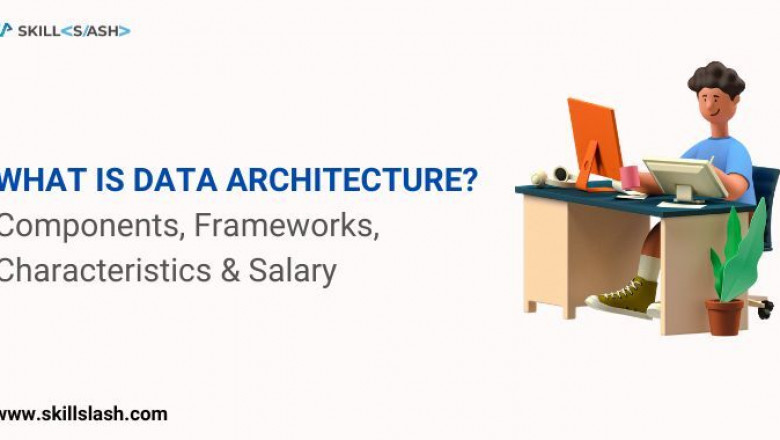views

A company's data architecture describes the procedures it follows to gather, store, and manage information. It explains how data assets and management resources are structured and organized. In this case, individuals who require the data will benefit from a well-organized set of records. It includes everything needed to keep data in an organization in working order, including rules, policies, models, and standards.
The data architecture's primary function is to translate business requirements into information and technical specifications, making it the backbone of any company plan. It controls how information is handled and moved around a company.
Through this article, where we already had a short introduction to data architecture, we will now understand the components, characteristics, and frameworks of data architecture and also the salary of professionals in this domain.
Data Architecture Components
Modern data architecture consists of many parts, including:
● Data Pipelines: It is an umbrella term for the activities involved in gathering data, cleaning it up, storing it, analyzing it, and transporting it. Data pipelines describe the complete process, beginning with where information is gathered and ending with how it is moved.
● Cloud storage: When people talk about "the cloud," they're referring to a remote data storage facility that can only be accessed via the internet.
● APIs: Through the application programming interface, a host and a requester can exchange data. The IP address is the connecting factor for the conversation. The API is capable of relaying a wide variety of data to the end user.
● AI & ML models: AI/ML facilitates an automated data architecture. Data collecting, labeling, etc., can be combined with computational reasoning to yield informed choices and predictions.
● Data streaming: The term "data streaming" describes the transfer of data in an uninterrupted stream from one location to another, where it must be processed for real-time analysis.
● Kubernetes: It is the system for managing the loads on data center servers, networks, and storage devices.
● Cloud computing: The term "cloud computing" is used to describe the method through which data is examined, stored, and managed in a remote server. The cloud handles all of the underlying hardware and software, so there's no need for you to worry about the ins and outs of your IT setup.
● Real-time analytics: In real-time analytics, data is analyzed as it is being collected to get insight. Organizations can make choices based on the results of this analysis.
Frameworks
A company can choose from several preexisting frameworks to best suit its data architecture.
● DAMA-DMBOK 2
The Data Management Body of Knowledge is a set of standards developed by DAMA International for use in the field of data management. The framework defines many terminologies in accordance with the standard definitions and serves as a guiding principle for data administration.
● Zachman Framework for Enterprise Architecture
The Zachman Framework was developed by IBM's John Zachman in the '80s. The "data" column contains several hierarchical levels. Business-critical architectural standards, a logical data model for the enterprise, a semantic model, the databases themselves, and a physical data model are all part of these layers.
● The Open Group Architecture Framework (TOGAF)
The enterprise software development community leverages the framework to create its products. During Phase C of TOGAF, the data architecture and the route plan are developed.
Data Structure Characteristics
The following are some distinguishing features of today's data architecture:
● User-driven
Users can get the information they need thanks to the data architecture. A lack of dynamic data and the inability to obtain it left decision-makers in the dark in the past. In the current environment, however, decision-makers can define their requirements and access them to accomplish business objectives, all thanks to the availability of a modern data structure.
● Designed around shared data
In today's architecture, data from several departments must be combined to create a unified whole. Information is consolidated into a single repository.
● Automated
Delivering and updating data used to be a time-consuming process. It took months to complete the processes. These tasks can now be accomplished in a matter of hours thanks to the use of automated technology. Moreover, automated pipelines allow the user to gain access to numerous forms of data.
● AI-driven
Machine learning (ML) and AI are used to fully automate the data structure (AI). Automated quality control procedures, as well as the categorization and sorting of incoming data into useful structures, are both possible thanks to the use of AI and ML. The automated system will use this information to suggest relevant data sets and analytics.
● Elastic
According to the data architecture, the company can expand or contract as necessary. Administrators can find solutions to issues thanks to the adaptability of data architecture.
● Simple
An effective data structure will have a straightforward layout that makes data transfer, data storage, data integration, and data analysis straightforward.
● Secure
Modern data architecture provides safety because it can spot new security risks and only shares information with those who have a legitimate business need to see it, according to strict policies.
Best Practices
When planning a data architecture approach, the following best practices should be encouraged.
● The process is driven by collaboration
Throughout an organization, the collaboration between the business and the IT department is crucial to the success of any given choice. Therefore, a well-designed data architecture promotes the achievement of cross-departmental objectives. Leaders in an organization are the ones who will decide what information is most useful for moving the needle. The data architect then uses this to lay out a plan for making the data available and tracking down its origins.
● Prioritize data governance
It's important to have reliable information to make sound choices. Similarly, highly relevant data is used in data mining architecture. In addition, the information should be tailored to the company's requirements. Thus, the responsibility of the data stewards is to ensure that the organization's data is accurate and up-to-date. In this situation, inside specialists can take on the role of data stewards to improve the accuracy of the data being collected.
● Attain agility
The data architecture needs to be flexible enough to include emerging technologies, which are essential in today's environment. As a result, the data architecture shouldn't revolve around a single piece of software or hardware. The data architecture needs to be flexible enough to adapt to new data kinds, as well as new tools and platforms, as they become available.
Data Architect Roles and Salary in India
In India, a data architect can expect to earn a median annual salary of ₹ 21,84,031. Below are some of the most common titles held by a data architect, as well as their corresponding average yearly salary.
● Database Architect: ₹ 23,16,877
● Senior Data Architect: ₹ 27,93,432
● Data Modeler: ₹ 12,51,051
● Data Warehouse Architect: ₹ 13,32,771
Final Words
We reach the final parts of the article, having successfully discussed data architecture, its components, best practices, characteristics, and the roles and salaries of data architecture professionals. If you aim to elevate in the tech domain, data science can help you start your journey. And, speaking of data science, Skillslash can help you build something big here. With Best Data Structure and Algorithm Course, and Data Science Course In Hyderabad with a placement guarantee, Skillslash can help you get into it with its Full Stack Developer Course in Hyderabad. you can easily transition into a successful data scientist. Get in touch with the support team to know more.












